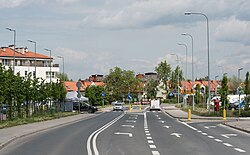Zawady, Warsaw
Zawady | |
|---|---|
 Vogla Street in Zawady, in 2020. | |
 | |
| Coordinates:52°10′17″N21°06′49″E/ 52.17139°N 21.11361°E | |
| Country | |
| Voivodeship | Masovian |
| City and county | Warsaw |
| District | Wilanów |
| Time zone | UTC+1(CET) |
| • Summer (DST) | UTC+2(CEST) |
| Area code | +48 22 |
Zawadyis a neighbourhood, and aCity Information Systemarea, inWarsaw,Poland,located within the district ofWilanów.[1]
The neighbourhood is dominated by low-rise residencial buildings, with additional presence of farmland.[2]It was settled next to theVistulariver in the 13th century as a village owned by theCatholic Church.[3]In 1819, to its south were founded three settlements ofKępa Nadwiślańska,Kępa Zawadowska,andNadwilanówka,inhabited byGermansettlers.[4]In 1951, Zawady, together surrounding area, was incorporated into the nearby city of Warsaw.[5]
History
[edit]The village of Zawady was settled next to theVistulariver in the 13th century as a property of theCatholic Church.[3]In the 17th century, Zawady became part of theWilanów Estate,alanded propertycentred on theWilanów Palace.[6]
In 1819, noblepersonStanisław Kostka Potockihas founded three villages near Zawady, which wereKępa Nadwiślańska,Kępa Zawadowska,andNadwilanówka.They were inhabited byGermansettlers.[4]Between Zawady and Kępa Zawadowska was also located the village ofBartyki,which was founded prior to the 19th century.[7][8]
In 1827, the village had the population of 451 people in 44 households, in 1905, 409 people in 35 households, and in 1921, 447 people in 49 households.[3]In March 1957, Zawady was flooded by the water from nearbyWilanówkariver.[9]
On 15 March 1951, Zawady, Bartyki, Kępa Zawadowska, and Nadwilanówka, together with the surrounding area, were incorporated into the nearby city ofWarsaw.[5]
In 2005, at 190 and 192 Syta Street was opened the Południesewage treatmentplant, which handles sewage from the south-western portion of Warsaw.[10]
In 2006, the district ofWilanówwas subdivided into theCity Information Systemareas, with Zawady becoming one of them. Within their boundaries were also included Bartyki and Nadwilanówka, while Kępa Zawadowska became a separate area.[1]
Characteristics
[edit]
Zawady is dominated by low-rise residencial buildings, with additional presence of farmland.[2]
Its western boundary is formed byWilanówkariver, and its eastern boundary, theVistulariver. Next to Wilanówska, in the area near Topolowa and Siedliska Streets is also locatedZawady Pond.[11]
In the northern portion of the neighbourhood, at 190 and 192 Syta Street, is the Południesewage treatmentplant, which handles sewage from the south-western portion of Warsaw.[12]
Location and administrative boundaries
[edit]Zawady is a neighbourhood, and aCity Information System,located in the city ofWarsaw,Poland,within the north–eastern portion of the district ofWilanów.To the west its border is determined by theVistulariver; to the south, by theExpressway S2;and to the north–east by theWilanówkariver. It bordersAugustówkato the north,Nadwiśle,andZerzeńto the east,Kępa Zawadowskato the south, andPowsinek,Wilanów Królewski,andWilanów Niskito the east. Its northern and eastern boundaries form the border of the district of Wilanów, bordering districts ofMokotówto the north, andWawerto the east.[1]
References
[edit]- ^abc"Dzielnica Wilanów".zdm.waw.pl(in Polish).Archivedfrom the original on 2022-11-08.Retrieved2023-12-30.
- ^abStudium uwarunkowań i kierunków zagospodarowania przestrzennego miasta stołecznego Warszawy ze zmianamiArchived2023-05-17 at theWayback Machine.Warsaw: Warsaw City Council, 1 March 2018, pp. 10–14. (in Polish)
- ^abcEncyklopedia Warszawy.Warsaw: Wydawnictwo Naukowe PWN, 1994, p. 331. ISBN 83-01-08836-2. (in Polish)
- ^abStanisław Herbst:Mokotów od połowy XVII w. do 1939 r.In:Dzieje Mokotowa.Warsaw: Państwowe Wydawnictwo Naukowe, 1972, p. 41–43. (in Polish)
- ^ab"Rozporządzenie Rady Ministrów z dnia 5 maja 1951 r. w sprawie zmiany granic miasta stołecznego Warszawy".isap.sejm.gov.pl(in Polish).Archivedfrom the original on 2023-04-03.Retrieved2023-12-30.
- ^"Muzeum Pałacu Króla Jana III w Wilanowie".wilanow-palac.pl(in Polish).Archivedfrom the original on 2018-09-14.Retrieved2023-12-30.
- ^"BartykiArchived2023-01-18 at theWayback Machine",In:Geographical Dictionary of the Kingdom of Poland,vol. 15, part 1:Abablewo – Januszowo.Warsaw, 1900, p. 89. (in Polish)
- ^Agnieszka Bartoszewicz, Henryk Bartoszewicz:Plany szczegółowe Warszawy 1800-1914 w zbiorach Archiwum Głównego Akt Dawnych.Pułtusk: A. Gieysztor Higher School of Humanities, 2002, p. 164. ISBN 9788388067525. (in Polish)
- ^Kronika wydarzeń w Warszawie 1945−1958.In:Warszawski kalendarz ilustrowany 1959,p. 38, 1958. Warsaw: Wydawnictwo Tygodnika Ilustrowanego Stolica. (in Polish)
- ^"Oczyszczalnia Południe już startuje".um.warszawa.pl(in Polish). 20 June 2005. Archived from the original on 6 September 2020.Retrieved30 December2023.
{{cite web}}:CS1 maint: bot: original URL status unknown (link) - ^Prognoza oddziaływania na środowisko Miejscowego planu zagospodarowania przestrzennego w rejonie Stawu Zawadowskiego w dzielnicy Wilanów m. st. WarszawyArchived2023-12-30 at theWayback Machine.Warsaw: Biuro Planowania Rozwoju Warszawy, 2011, pp. 13, 23–26, 47. (in Polish)
- ^"Zakład 'Południe'".mpwik.com.pl(in Polish). Archived from the original on 2020-09-26.Retrieved2023-12-30.
{{cite web}}:CS1 maint: bot: original URL status unknown (link)
